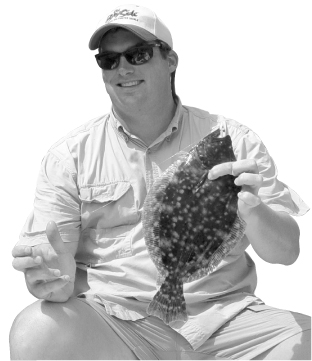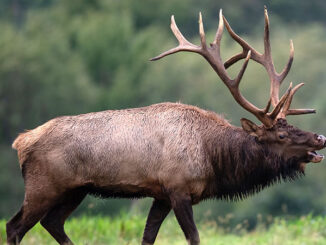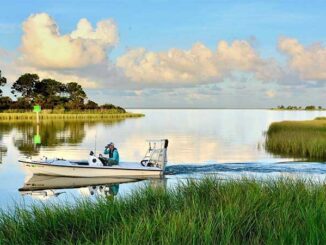
Sabine Lake definitely feels the impact of rain water this time of year, but its ample flounder stocks don’t seem to mind.
The speed of the man’s dissertation was positively stunning. We hadn’t even ordered at the Orange, Texas, Waffle House, and Capt. Skip James (409-886-5341) was in his element, giving me the lowdown on the trip on which we were about to embark.
Flounder biological information, historical catches, feeding habits, basic techniques, advanced techniques, they were all there, being spewed rapid-fire in response to a simple statement: “So, what have you got planned for us today?”
Howard Hammonds of Old Bayside Bait Co. — never one to back down from a conversation — just ducked his head into a menu and smiled, knowing what must be going through my head.
He and a number of outdoor writers from around the region had been treated to the spiel for several days now. They had also been treated to some outstanding action on flounder in a decidedly sophisticated technique.
“Howard won’t let us use bait, of course. It’s almost like he’s trying to convince you boys of something or sell y’all on something,” said James with a bone-dry poker face. “I’ve tried and tried to get him to let me use just a little bit of shrimp on the jig, but he’s having none of it.”
“Shoot, man, everybody said you were the best at this game,” said Hammonds, finally unable to resist the bait himself. “Anybody can catch those fish with shrimp. We gotta do it the right way.”
James shook his head and kept up the feigned disdain for such restrictions for a moment before picking up where he left off in his studies — both anecdotal and scientific — of the flounder population of Sabine Lake.
“I’ve actually gotten grant money, all on my own, filled out the paperwork and everything, and won tagging studies on these fish,” said James. “You could say I’ve gotten a little obsessive about them in the past.”
Obsessive is something one almost has to be in order to make it as a guide on Sabine Lake. Whereas Calcasieu fishing turns sour when rainwater inundates the lake from the Calcasieu River, Sabine gets fresh water from three rivers, the Nueces, the Sabine and the Neches.
Spring is the time when much of the guiding business takes place, and having intricate knowledge of a species helps James keep customers happy when rainwater sweetens the lake and chases the trophy speckled trout from their normal haunts.
“Flounder still need salt water, but they’re a little more tolerant of fresh water than a trout. The migration of the flounder through that pass is going to happen. Fresh water might keep the fish on the move, but they’ll still be there,” said James.
Even though the distant smokestacks of the Port Arthur, Texas, industrial region told a different story, there was nary a breeze blowing as we entered the lake from a northern tributary.
James tried to keep up the appearance of the grizzled veteran who had seen it all in the many years of guiding the lake, but close inspection of his weather-beaten face revealed a trace of giddiness.
It had been a long spring season with rain and wind doing equal parts in making the busy time of the year an exercise in frustration. The fishing had been good enough, he explained as we turned south, but the lake’s ample helping of rainwater had served to keep the fish on the move and the captain scratching his head.
Flounder make a migration into the estuary each spring via Sabine Pass and mass along the Louisiana shoreline — alongside the Sabine National Wildlife Refuge — in and around the numerous bayous that feed the lake. The Texas side of the lake is the polar opposite of the Louisiana side with its sprawling industrial growth and the Sabine/Neches Ship Channel.
For a species with the unquestioned reputation for tablefare, the flounder has a curiously understated following in Louisiana. Speckled trout and redfish dominate inshore catches, and are even more overwhelming in fishing efforts compared to the mysterious and delicious flatfish.
Part of the reason for the fish’s status as a second-class citizen is that many of the better geographic areas to catch flounder are adjacent to some of the most acclaimed regions for speckled trout.
Venice and the eastern end of Lake Pontchartrain are two areas with not only dedicated followings of flounder, but tremendous reputations for holding numbers of speckled trout that make anglers swoon.
On the other end of the state, Sabine Lake has produced numbers of trophy trout in years past that would be the envy of both above-mentioned locations. It also is the site of the outstanding spring flounder run on the Louisiana side of the sprawling border lake.
We began our trip with a quick survey of the conditions. A falling tide dictated working the mouth of a small bayou leading to the interior of Sabine NWR. The lecture of bait presentation began anew, and just as I thought perhaps James was overly attentive to detail, he quickly leaned back on the stiff spinning rod and reeled like mad.
“You gotta hit ’em fast and hard,” said James as a 2-pounder came into view and was quickly snatched onto the bottom of the boat before a picture could even be thought of. “That boney mouth of theirs is unforgiving.”
A few casts later, my true education was just beginning. I was scooting the jig along in the proper 2-inch hops, keeping the line tight as the slight current worked it along when a slight tap and accompanying heavy feeling came through the rod.
James saw the strike and hissed a “Git ‘im” my way and offered a hearty “There ya go!” when the rod came tight. It was, however, very short-lived as the unseen fish quickly loosed itself when the drag squealed what was, to me, a happy tune.
“Nope, can’t have that fishing like this. You’ve got to crank that drag down and set that hook hard. These fish are masters of getting off,” said James. “You want to get them coming toward the boat. It’s a lot easier with a little bit of shrimp, but Howard threw them out of the boat yesterday, so I didn’t even try today.
“Your rod is also very important. It has to have some backbone to it. I like spinning tackle for this kind of fishing, but it’s a personal preference.”
After taking a few fish off of the flats and associated ledges in the bayou itself, James was off to another similar location. Similar spotty success had us scrambling, as an early departure was necessary for one of our guests.
Though the tide was wrong for the area, we began working a large flat in between two bayous. Even with James’ extensive knowledge and studies of the flounder in this area, dirty, fresh water was giving us fits.
“Rising tides are generally what brings these fish onto the flats, but there should be a few here right now,” said James as he began slowly working south, controlling our drift into a building southeast breeze as only a battle-tested guide can do. “Work the bait the same way, but you got to really stick ’em here, as we’ll be making much longer casts.”
Flood tides, which are common in the prime early spring months, require a slightly different technique. Especially on the intermittent cane-lined shorelines, baitfish seek shelter in the root systems. While fishing can be tough when the water is actually in the grass, it can turn on in an instant when the water begins dropping and the bait is forced out of the sanctuaries.
“That’s kind of a little-known tactic in that it doesn’t last very long,” James said. “As soon as the water falls out of there, the fish get back to normal. It’s one of the best times to catch really big flounder. They’re the survivors and they know when the food is going to be most available.”
These big fish, similar to large trout, are often in less need of as much food as normal-sized flounders. Therefore, they can afford to be picky when eating. A noisy approach to a location can scatter them to the next stand of canes before a lure can even be presented.
“The best way is to approach a stand of canes from the side. This will allow you to fish as close or as far from them as you wish. One of the most important things to remember is to take your time,” said James, reiterating the notion that it’s difficult to tell just how far off of the shoreline the fish might be holding. “The good news is that once you’ve located where they are in relation to the shoreline, chances are you’re going to find the majority of the fish in that area as well.”
We pounded several long, historically productive banks for a while and were able to dredge several more flatfish destined for stuffing from the bank. A few came from as far as 20 yards off of the shoreline, a position James classified as typical more of a slack-tide period.
“They’ll often scatter outside of a bayou mouth anywhere from 3 to 5 feet deep. It’s very important to use a very stealthy approach in this instance, even more so than usual,” said James. “They’ll still feed if you put the bait in front of them, but drifting and using the trolling motor only to correct your position is the best way to have success.”
Some of the best flats for fishing on a rising tide are adjacent to Johnson Bayou, Bridge Bayou and Three Bayou moving north. Fishing these large areas may seem daunting, but as is mentioned above, when flounder are found in one particular pattern, many fish can be taken around structure as obvious as a grassy point or as hidden as a subtle ledge 10 yards off the shoreline.
North winds can plunge eastern shorelines into a muddy mess, forcing James into fishing places such as Coffee Ground Cut, Whiskey Bayou and Willow Bayou.
Northerlies often mean more current than usual coming from these tributaries, meaning more food flowing past their noses in addition to the benefit of cleaner water.
Flounder season is a fall thing in the southeast portion of the state, but springtime, wind and rain notwithstanding, is primetime for scooting jigs across the bottom of the westernmost water in the state.
It doesn’t hurt to up your odds with a little taste of shrimp on the hook. Just don’t tell your friendly regional lure rep.

